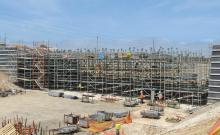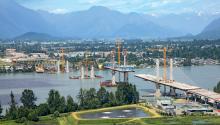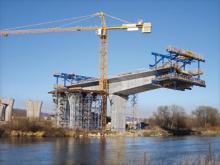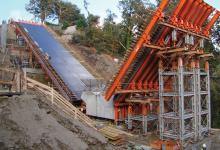Australia’s Hunter Valley will benefit from a new high speed expressway, which is currently under construction - Simon Gould reports Located two hours north of Sydney, the Hunter Valley region in New South Wales is one of Australia’s largest producers of coal and wine. With international demand, particularly from Asia, for both continuing to increase, a significant upgrade of infrastructure was required between the region and the port of Newcastle, the world’s largest coal export port. However the strict en
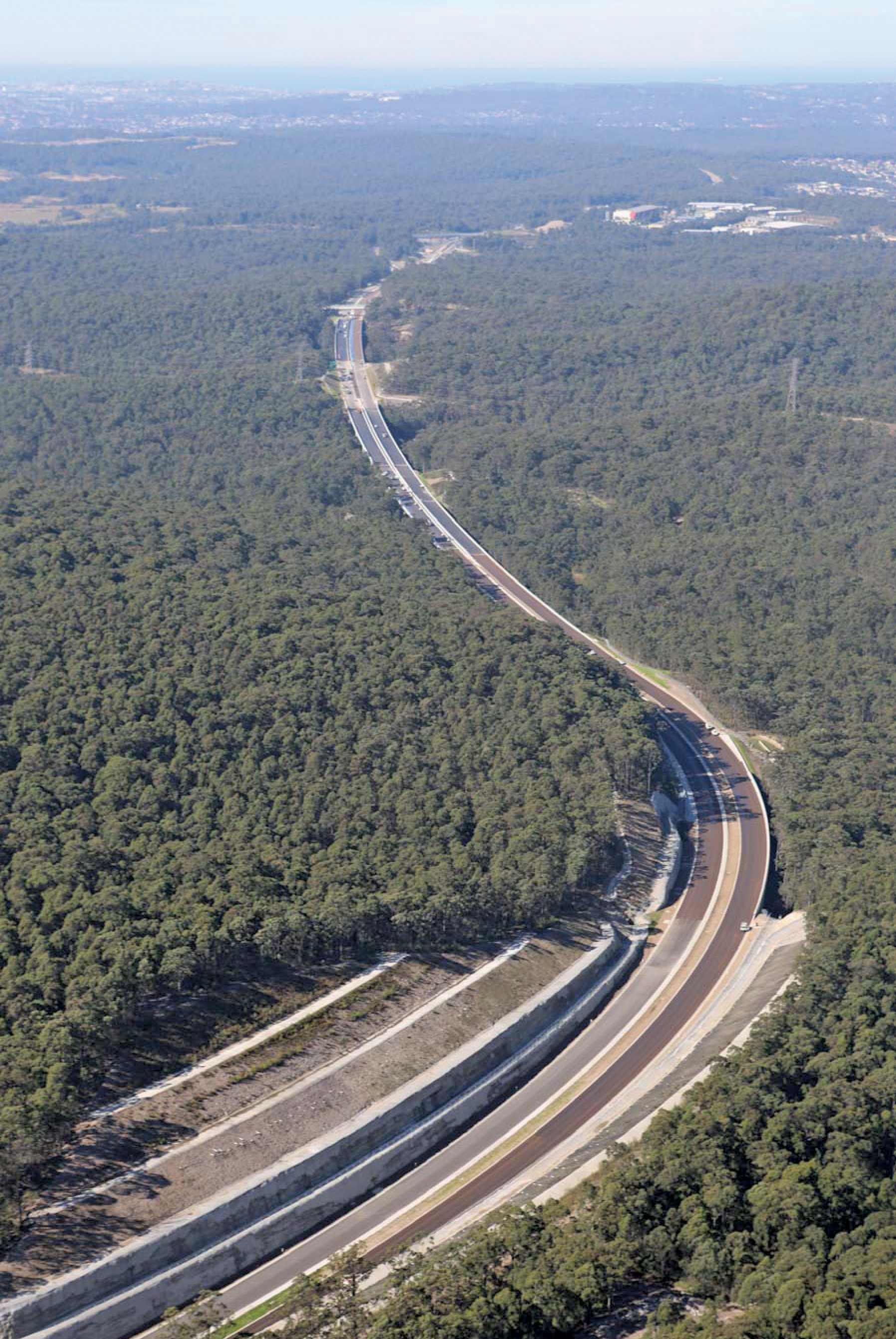
The Hunter Expressway project has been constructed through challenging terrain
Australia’s Hunter Valley will benefit from a new high speed expressway, which is currently under construction - Simon Gould reports
Located two hours north of Sydney, the Hunter Valley region in New South Wales is one of Australia’s largest producers of coal and wine. With international demand, particularly from Asia, for both continuing to increase, a significant upgrade of infrastructure was required between the region and the port of Newcastle, the world’s largest coal export port. However the strict environmental requirements of the region, particularly with regard to minimising the impact on the hugely important wine trade that is a cornerstone of the local economy, have provided their own challenges. Meanwhile the terrain itself, with rugged countryside on much of the surface and former mine workings underground along some of the route, mean the project is not straightforward. For the Hunter Expressway Alliance team led by Peter Chatburn of2642 Thiess, this project was very tricky indeed. He said, “The first drive through this job was a challenge in itself, some of the terrain you couldn’t drive through, in fact you could hardly walk through it.”
The AUS$1.7 billion Hunter Expressway is jointly funded, with the Australian Government providing AUS$1.5 billion and the NSW Government contributing up to AUS$200 million. The project is being managed by the New South Wales Transport Roads and Maritime Services (RMS) while the team involved in ITS construction includes Thiess,2693 Parsons Brinckerhoff, Hyder Consulting and 1362 Abigroup Contractors.
The new Hunter Expressway project is being designed with the aim of providing a more efficient and direct route for heavy vehicles travelling between the Port of Newcastle and Upper Hunter, northern and central NSW and central Queensland. Moving the heavy truck traffic from the existing routes will improve safety for commuters and also reduce congestion. Once complete it will cut travel times between Newcastle and the Hunter region by 28 minutes. It will also relieve congestion between Newcastle and the towns of Thornton, Maitland and Rutherford, with forecasted reductions in traffic of 15,000-30,000 vehicles/day from the current level of 60,000/day.
According to Thiess, the Hunter Expressway project has been constructed through rugged country with minimal environmental disturbance. This 40km, four-lane route is due to open by the end of December 2013 and features a wide range of construction features. These include concrete and asphalt paving, bridge construction, installation of wire rope and traffic barriers, noise walls and landscaping.
The project includes two grade-separated interchanges as well as overbridges, whilst areas for light and heavy vehicles will be built on both sides of the expressway. Along a section measuring 13km, there are no less than 29 bridges of many different types, although the three viaducts with their precast, segmental balanced cantilever structures, have been particularly complex. Thiess senior project manager Axel Armstrong said, “I remember standing where one of the viaduct abutments was to be and thinking, how the hell are we going to do this?”
The three high viaducts run over areas where mine subsidence was a major concern and provided the engineering team with interesting technical challenges. These three viaducts are designed to span the steep gullies through the Sugarloaf Range and are located 1.4 to 2.7km west of the F3 Freeway.
The viaducts have a total length of 787m and are up to 47m in height above the gully floors. The route of the Hunter Expressway crosses the Sugarloaf Range to the west of the F3 Freeway and involves crossings of a number of deep valleys. At three of these sites large viaducts are being used to carry the expressway over the valleys.
The segmental balanced cantilever viaducts are amongst the longest span lengths for this type of structure ever built in Australia. And one of the most difficult parts of the project has been the bridge over the F3 Freeway, which curves in two planes and was launched over live traffic. According to Thiess this has been one of the more complex incremental bridge launches ever carried out in Australia.
The viaducts have lengths of approximately 330m, 255m and 200m and span lengths of up to 75m. There are twin viaducts at each site making a total of six structures. The viaducts have concrete box girder superstructures supported on hollow concrete piers. The decks are 11.5m between kerbs. The depth of the box girders varies from 3m to 4.2m, which provides for two lanes of traffic in each direction, and shoulders.
The height of the decks above ground at the piers varies from 34-42m. To minimise the amount of on-site construction the piers and decks are being constructed using precast concrete elements, known as segments.
This reduces the risks of working at heights and of damaging the environment through spills and additional clearing. The time for construction on site is also greatly reduced.
Erection of the columns is being carried out from ground level using large cranes that lift each of the segments into place. Tensioned steel strands are then used to hold the precast segments together and carry the loads from the superstructure.
The deck segments are assembled using a specially designed steel launching truss which sits on top of the piers and carries the segments from the transporter to their final location.
The launching truss contains approximately 1000tonnes of steel when fully assembled and is 165m in length and 16m high. The superstructure is assembled using the ‘balanced cantilever’ method, which involves placing segments alternately on either side of the pier until the superstructure reaches the mid-spans. Tensioned steel strands are used to hold the segments together and carry the loads from the superstructure and traffic.
The precast concrete segments are being produced in a casting yard adjacent to the main project office near Buchanan. This yard has been set up specifically for the project, together with a concrete batch plant to supply concrete for the bridgeworks.
There are 177 segments for the piers and 566 segments for the superstructures. During production two moulds are used for the column segments and three moulds for the deck segments. The segments weigh up to 11 tonnes. Moving these large segments from the casting yard to the bridges involves the use of special transporters.
The three viaducts that cross the deep valleys in the Sugarloaf Range are a key feature of the Hunter Expressway project. These bridge viaducts provide an 800m-wide fauna corridor across the project. A further 10 bridge structures, eight culvert underpasses and eight arboreal crossings will be constructed across the project.
They will provide habitat connectivity and reduce roadkill during operation of the project. Waterway bridges and culverts will also be built to provide fish passage across the project.
An extensive program of nest box installation was undertaken and more than 400 nest boxes were installed in bushland areas across the 40km of the project.
These nest boxes provide replacement habitat to native fauna impacted by the project and offset the tree hollows removed due to vegetation clearing.
The majority of the 40km length of the Hunter Expressway will be provided with fauna exclusion fencing to funnel native wildlife to fauna underpasses and to minimise roadkill. This exclusion fencing consists of “floppy-top” fencing designed to prevent climbing animals such as koalas from climbing the fence and entering areas of high-speed traffic flow.
To minimise the long-term impacts of the project on adjacent vegetation the project focuses on rehabilitating areas disturbed by construction. This rehabilitation work uses native vegetation and will encompass the rehabilitation of approximately 140 hectares of land and planting more than 300,000 plants across the length of the project.
RMS and its construction partners have undertaken an extensive native seed collection program since 2001 to ensure sufficient seed is available for rehabilitation. Seed has been collected from many of the vegetation communities affected by the project.
These seed resources will either be propagated in a nursery environment for planting or scattered across the project in dedicated areas to germinate naturally. As far as possible, RMS will endeavour to recreate or supplement the vegetation communities affected by the project in the areas where they have been affected.
To encourage native vegetation to regenerate naturally RMS requires its construction partners to remove and store topsoil along the length of the project. Topsoil is collected and stored within discrete units that typically coincide with the existing vegetation communities and soil types.
The project also included extensive, complex and challenging work relating to mine void treatment, the term used to describe the filling of long-abandoned coal mine workings beneath the ground. These voids needed to be filled to ensure the stability of the ground before construction could start, as Thiess was well aware the old workings represented a major threat to the integrity of bridge foundations. The team accessed the historic plans showing details of where the old mine workings lay, as well as carrying out investigation work where more precise location of the underground cavities was required.
The process of filling the voids involved drilling small diameter boreholes into the old mine workings at depths of 70-120m. Grout was then pumped down the boreholes and into the mines. The grout is a flowable mixture of cement, water and flyash, which hardens after one day. Flyash is a by-product of coal fired power stations and its use meets the tough regulations of the state of New South Wales. The grout fills the void left by coal mining and prevents collapse of the mine void, as well as addressing the risk of movement in the ground above the mine.
This highly specialised work was needed as once coal mining activities are completed, numerous voids are left where coal has been extracted from the seams. The voids do leave a potential for the rock above the coal mine to collapse, which can result in subsidence at ground surface level and potentially damage any structures that are built above the mines. On the eastern section of the project, the large bridges would have been vulnerable to subsidence, so addressing the issue of the coal mine voids was a priority for the project team, which developed the plan to use the special grout filling.
This concept has been used widely in many areas where coal mining activities have been undertaken in the past (such as in Europe and the US) and the technology is now well-proven. Once this special mix has been placed inside the voids it hardens and then prevents collapse of the mine workings, stabilising the rock above the mine so that no subsidence at the surface will occur.
The drilling work required was extensive and around 2,000 boreholes were sunk into the ground, with a total length of 145,000m. The extent of the former mine workings meant that approximately 200,000m3 of grout then had to be pumped down into the numerous voids to stabilise the ground and address concerns over potential subsidence. The work to drill and fill the mine voids was a lengthy process and started in December 2010, with this then being completed in April 2012.
Highly specialised equipment was required to carry out this mine filling work and included a number of purpose-built rigs to drill through the rock.
Once these initial boreholes had been sunk, down-hole survey instrumentation and video cameras were used to provide the project team with a view of the extent of the voids before, during and after the grout filling work was carried out.
Two concrete batch plants were required to produce the grout used for the filling operations.
These concrete batch plants had to be specially modified to suit the relatively fluid mixture used for filling.
Grout was pumped from the adapted batch plants through temporary pipelines and into the drill holes.
This process itself was subject to environmental restrictions and the team employed a total of 3,000m of pipes, which were laid on tyres to reduce the impact on the environment.
To ensure that the void filling work was carried out properly, the Hunter Expressway Alliance partnered with Keller Minefill, a company specialising in this field.
A team of more than 70 personnel and comprising engineers, surveyors, drafters, technicians, safety and environmental officers, quality staff and field staff to operate the drill rigs, cranes and batch plant worked collaboratively to complete the tricky task. But with the former mine workings stabilised, Thiess believes it has developed a new skill set that will come in useful for other projects in the future.
So far more than 97% of the five million m3 of earthworks for the project have been completed. Paving is continuing along the length of the project and as of August 2013 more than 79% of the concrete paving required had been completed. Meanwhile over 62% of the asphalt paving has already been finished and this portion of the project should be ready shortly.
At present the noise attenuation features are being erected in various locations, including near Wine Country Drive in Branxton and near the bridges over the railway line, north of Branxton. In all, the Hunter Valley expressway requires some 5.3km of noise walls on the project with close to 3.5km having already been installed.
Located two hours north of Sydney, the Hunter Valley region in New South Wales is one of Australia’s largest producers of coal and wine. With international demand, particularly from Asia, for both continuing to increase, a significant upgrade of infrastructure was required between the region and the port of Newcastle, the world’s largest coal export port. However the strict environmental requirements of the region, particularly with regard to minimising the impact on the hugely important wine trade that is a cornerstone of the local economy, have provided their own challenges. Meanwhile the terrain itself, with rugged countryside on much of the surface and former mine workings underground along some of the route, mean the project is not straightforward. For the Hunter Expressway Alliance team led by Peter Chatburn of
The AUS$1.7 billion Hunter Expressway is jointly funded, with the Australian Government providing AUS$1.5 billion and the NSW Government contributing up to AUS$200 million. The project is being managed by the New South Wales Transport Roads and Maritime Services (RMS) while the team involved in ITS construction includes Thiess,
The new Hunter Expressway project is being designed with the aim of providing a more efficient and direct route for heavy vehicles travelling between the Port of Newcastle and Upper Hunter, northern and central NSW and central Queensland. Moving the heavy truck traffic from the existing routes will improve safety for commuters and also reduce congestion. Once complete it will cut travel times between Newcastle and the Hunter region by 28 minutes. It will also relieve congestion between Newcastle and the towns of Thornton, Maitland and Rutherford, with forecasted reductions in traffic of 15,000-30,000 vehicles/day from the current level of 60,000/day.
According to Thiess, the Hunter Expressway project has been constructed through rugged country with minimal environmental disturbance. This 40km, four-lane route is due to open by the end of December 2013 and features a wide range of construction features. These include concrete and asphalt paving, bridge construction, installation of wire rope and traffic barriers, noise walls and landscaping.
The project includes two grade-separated interchanges as well as overbridges, whilst areas for light and heavy vehicles will be built on both sides of the expressway. Along a section measuring 13km, there are no less than 29 bridges of many different types, although the three viaducts with their precast, segmental balanced cantilever structures, have been particularly complex. Thiess senior project manager Axel Armstrong said, “I remember standing where one of the viaduct abutments was to be and thinking, how the hell are we going to do this?”
The three high viaducts run over areas where mine subsidence was a major concern and provided the engineering team with interesting technical challenges. These three viaducts are designed to span the steep gullies through the Sugarloaf Range and are located 1.4 to 2.7km west of the F3 Freeway.
The viaducts have a total length of 787m and are up to 47m in height above the gully floors. The route of the Hunter Expressway crosses the Sugarloaf Range to the west of the F3 Freeway and involves crossings of a number of deep valleys. At three of these sites large viaducts are being used to carry the expressway over the valleys.
The segmental balanced cantilever viaducts are amongst the longest span lengths for this type of structure ever built in Australia. And one of the most difficult parts of the project has been the bridge over the F3 Freeway, which curves in two planes and was launched over live traffic. According to Thiess this has been one of the more complex incremental bridge launches ever carried out in Australia.
The viaducts have lengths of approximately 330m, 255m and 200m and span lengths of up to 75m. There are twin viaducts at each site making a total of six structures. The viaducts have concrete box girder superstructures supported on hollow concrete piers. The decks are 11.5m between kerbs. The depth of the box girders varies from 3m to 4.2m, which provides for two lanes of traffic in each direction, and shoulders.
The height of the decks above ground at the piers varies from 34-42m. To minimise the amount of on-site construction the piers and decks are being constructed using precast concrete elements, known as segments.
This reduces the risks of working at heights and of damaging the environment through spills and additional clearing. The time for construction on site is also greatly reduced.
Erection of the columns is being carried out from ground level using large cranes that lift each of the segments into place. Tensioned steel strands are then used to hold the precast segments together and carry the loads from the superstructure.
The deck segments are assembled using a specially designed steel launching truss which sits on top of the piers and carries the segments from the transporter to their final location.
The launching truss contains approximately 1000tonnes of steel when fully assembled and is 165m in length and 16m high. The superstructure is assembled using the ‘balanced cantilever’ method, which involves placing segments alternately on either side of the pier until the superstructure reaches the mid-spans. Tensioned steel strands are used to hold the segments together and carry the loads from the superstructure and traffic.
The precast concrete segments are being produced in a casting yard adjacent to the main project office near Buchanan. This yard has been set up specifically for the project, together with a concrete batch plant to supply concrete for the bridgeworks.
There are 177 segments for the piers and 566 segments for the superstructures. During production two moulds are used for the column segments and three moulds for the deck segments. The segments weigh up to 11 tonnes. Moving these large segments from the casting yard to the bridges involves the use of special transporters.
The three viaducts that cross the deep valleys in the Sugarloaf Range are a key feature of the Hunter Expressway project. These bridge viaducts provide an 800m-wide fauna corridor across the project. A further 10 bridge structures, eight culvert underpasses and eight arboreal crossings will be constructed across the project.
They will provide habitat connectivity and reduce roadkill during operation of the project. Waterway bridges and culverts will also be built to provide fish passage across the project.
An extensive program of nest box installation was undertaken and more than 400 nest boxes were installed in bushland areas across the 40km of the project.
These nest boxes provide replacement habitat to native fauna impacted by the project and offset the tree hollows removed due to vegetation clearing.
The majority of the 40km length of the Hunter Expressway will be provided with fauna exclusion fencing to funnel native wildlife to fauna underpasses and to minimise roadkill. This exclusion fencing consists of “floppy-top” fencing designed to prevent climbing animals such as koalas from climbing the fence and entering areas of high-speed traffic flow.
To minimise the long-term impacts of the project on adjacent vegetation the project focuses on rehabilitating areas disturbed by construction. This rehabilitation work uses native vegetation and will encompass the rehabilitation of approximately 140 hectares of land and planting more than 300,000 plants across the length of the project.
RMS and its construction partners have undertaken an extensive native seed collection program since 2001 to ensure sufficient seed is available for rehabilitation. Seed has been collected from many of the vegetation communities affected by the project.
These seed resources will either be propagated in a nursery environment for planting or scattered across the project in dedicated areas to germinate naturally. As far as possible, RMS will endeavour to recreate or supplement the vegetation communities affected by the project in the areas where they have been affected.
To encourage native vegetation to regenerate naturally RMS requires its construction partners to remove and store topsoil along the length of the project. Topsoil is collected and stored within discrete units that typically coincide with the existing vegetation communities and soil types.
The project also included extensive, complex and challenging work relating to mine void treatment, the term used to describe the filling of long-abandoned coal mine workings beneath the ground. These voids needed to be filled to ensure the stability of the ground before construction could start, as Thiess was well aware the old workings represented a major threat to the integrity of bridge foundations. The team accessed the historic plans showing details of where the old mine workings lay, as well as carrying out investigation work where more precise location of the underground cavities was required.
The process of filling the voids involved drilling small diameter boreholes into the old mine workings at depths of 70-120m. Grout was then pumped down the boreholes and into the mines. The grout is a flowable mixture of cement, water and flyash, which hardens after one day. Flyash is a by-product of coal fired power stations and its use meets the tough regulations of the state of New South Wales. The grout fills the void left by coal mining and prevents collapse of the mine void, as well as addressing the risk of movement in the ground above the mine.
This highly specialised work was needed as once coal mining activities are completed, numerous voids are left where coal has been extracted from the seams. The voids do leave a potential for the rock above the coal mine to collapse, which can result in subsidence at ground surface level and potentially damage any structures that are built above the mines. On the eastern section of the project, the large bridges would have been vulnerable to subsidence, so addressing the issue of the coal mine voids was a priority for the project team, which developed the plan to use the special grout filling.
This concept has been used widely in many areas where coal mining activities have been undertaken in the past (such as in Europe and the US) and the technology is now well-proven. Once this special mix has been placed inside the voids it hardens and then prevents collapse of the mine workings, stabilising the rock above the mine so that no subsidence at the surface will occur.
The drilling work required was extensive and around 2,000 boreholes were sunk into the ground, with a total length of 145,000m. The extent of the former mine workings meant that approximately 200,000m3 of grout then had to be pumped down into the numerous voids to stabilise the ground and address concerns over potential subsidence. The work to drill and fill the mine voids was a lengthy process and started in December 2010, with this then being completed in April 2012.
Highly specialised equipment was required to carry out this mine filling work and included a number of purpose-built rigs to drill through the rock.
Once these initial boreholes had been sunk, down-hole survey instrumentation and video cameras were used to provide the project team with a view of the extent of the voids before, during and after the grout filling work was carried out.
Two concrete batch plants were required to produce the grout used for the filling operations.
These concrete batch plants had to be specially modified to suit the relatively fluid mixture used for filling.
Grout was pumped from the adapted batch plants through temporary pipelines and into the drill holes.
This process itself was subject to environmental restrictions and the team employed a total of 3,000m of pipes, which were laid on tyres to reduce the impact on the environment.
To ensure that the void filling work was carried out properly, the Hunter Expressway Alliance partnered with Keller Minefill, a company specialising in this field.
A team of more than 70 personnel and comprising engineers, surveyors, drafters, technicians, safety and environmental officers, quality staff and field staff to operate the drill rigs, cranes and batch plant worked collaboratively to complete the tricky task. But with the former mine workings stabilised, Thiess believes it has developed a new skill set that will come in useful for other projects in the future.
So far more than 97% of the five million m3 of earthworks for the project have been completed. Paving is continuing along the length of the project and as of August 2013 more than 79% of the concrete paving required had been completed. Meanwhile over 62% of the asphalt paving has already been finished and this portion of the project should be ready shortly.
At present the noise attenuation features are being erected in various locations, including near Wine Country Drive in Branxton and near the bridges over the railway line, north of Branxton. In all, the Hunter Valley expressway requires some 5.3km of noise walls on the project with close to 3.5km having already been installed.

